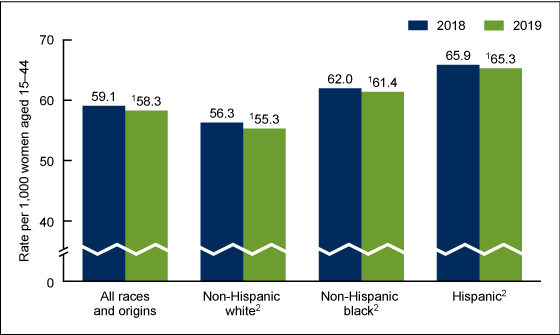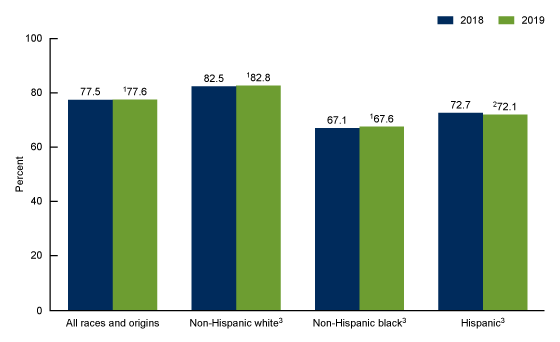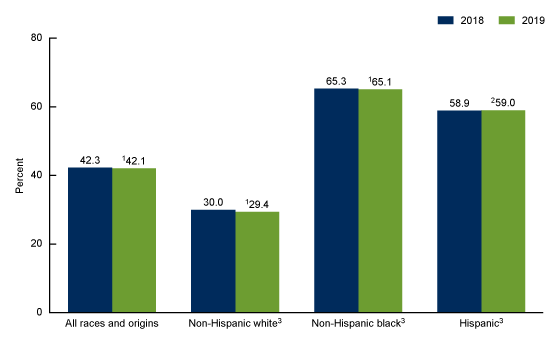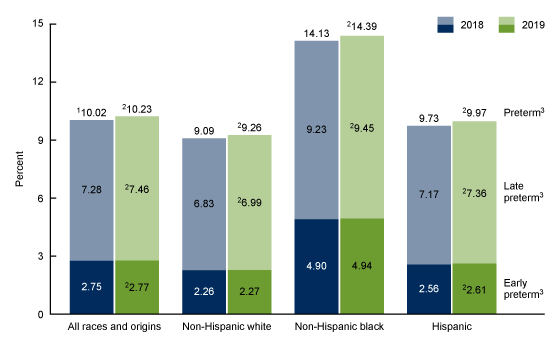Births in the United States, 2019
- Key findings
- The general fertility rate declined for all three race and Hispanic-origin groups in 2019.
- First trimester prenatal care increased in the United States in 2019.
- Medicaid as the source of payment for the delivery declined in 2019.
- The U.S. preterm birth rate increased 2% between 2018 and 2019.
- Summary
- Definitions
- Data source and methods
- About the authors
- References
- Suggested citation
PDF Version (389 KB)
Key findings
Data from the National Vital Statistics System
- The U.S. general fertility rate declined 1% in 2019 to 58.3 births per 1,000 women aged 15–44 from 59.1 in 2018; rates declined for non-Hispanic white, non-Hispanic black, and Hispanic women.
- The percentage of mothers beginning prenatal care in the first trimester of pregnancy increased from 2018 to 2019 among non-Hispanic white and non-Hispanic black women, but decreased among Hispanic women.
- Medicaid as the source of payment for the delivery declined from 42.3% to 42.1% from 2018 to 2019.
- The preterm birth rate rose 2% from 2018 to 2019 from 10.02% to 10.23%; rates rose for each race and Hispanic origin group.
This report presents selected highlights from 2019 final birth data on key demographic, health care utilization, and infant health indicators. General fertility rates (the number of births per 1,000 women aged 15–44), prenatal care timing (the percentage of mothers with first trimester care), source of payment for the delivery (the percentage of births covered by Medicaid), and preterm birth rates are presented. All indicators are compared between 2018 and 2019 and are presented for all births and for the three largest race and Hispanic-origin groups: non-Hispanic white, non-Hispanic black, and Hispanic.
Keywords: general fertility rates, prenatal care, Medicaid, preterm birth, National Vital Statistics System
The general fertility rate declined for all three race and Hispanic-origin groups in 2019.
- The general fertility rate for the United States declined 1% in 2019 to 58.3 per 1,000 women aged 15–44 from 59.1 in 2018 (Figure 1).
- Fertility rates declined for the three largest race and Hispanic-origin groups from 2018 to 2019, down 2% for non-Hispanic white women (56.3 to 55.3) and 1% for non-Hispanic black (62.0 to 61.4) and Hispanic (65.9 to 65.3) women.
- In 2019, the fertility rate was highest for Hispanic women, followed by non-Hispanic black and non-Hispanic white women.
Figure 1. General fertility rates, by race and Hispanic origin of mother: United States, 2018 and 2019
1Significant decline from 2018 (p < 0.05).
2Significant difference between all race and Hispanic-origin groups (p < 0.05).
NOTE: Access data table for Figure 1.
SOURCE: National Center for Health Statistics, National Vital Statistics System, Natality
First trimester prenatal care increased in the United States in 2019.
- The percentage of women beginning prenatal care in the first trimester of pregnancy increased from 77.5% to 77.6% between 2018 and 2019 (Figure 2).
- First trimester prenatal care rose for non-Hispanic white (82.5% to 82.8%) and non-Hispanic black (67.1% to 67.6%) women, but declined for Hispanic (72.7% to 72.1%) women.
- In 2019, initiation of prenatal care in the first trimester was highest among non-Hispanic white women, followed by Hispanic women and non-Hispanic black women.
Figure 2. Prenatal care beginning in the first trimester, by race and Hispanic origin of mother: United States, 2018 and 2019
1Significant increase from 2018 (p < 0.05).
2Significant decline from 2018 (p < 0.05).
3Significant difference between all race and Hispanic-origin groups (p < 0.05).
NOTE: Access data table for Figure 2.
SOURCE: National Center for Health Statistics, National Vital Statistics System, Natality.
Medicaid as the source of payment for the delivery declined in 2019.
- In 2019, the percentage of women for whom Medicaid was the source of payment for the delivery declined to 42.1% from 42.3% in 2018 (Figure 3). Medicaid as the source of payment declined for non-Hispanic white (30.0% to 29.4%) and non-Hispanic black (65.3% to 65.1%) women and increased for Hispanic (58.9% to 59.0%) women.
- Non-Hispanic black women were more than twice, and Hispanic women were twice as likely as non-Hispanic white women to have births covered by Medicaid in 2019 (65.1% and 59.0% compared with 29.4%).
Figure 3. Medicaid as source of payment for the delivery, by race and Hispanic origin of mother: United States, 2018 and 2019
11Significant decline from 2018 (p < 0.05).
2Significant increase from 2018 (p < 0.05).
3Significant difference between all race and Hispanic-origin groups (p < 0.05).
NOTE: Access data table for Figure 3.
SOURCE: National Center for Health Statistics, National Vital Statistics System, Natality.
The U.S. preterm birth rate increased 2% between 2018 and 2019.
- The percentage of newborns delivered preterm rose to 10.23% in 2019, a 2% increase over the 2018 rate of 10.02% (Figure 4).
- Preterm rates increased 2% among births to each of the largest race and Hispanic-origin groups from 2018 to 2019; non-Hispanic white (9.09% to 9.26%), non-Hispanic black (14.13% to 14.39%), and Hispanic (9.73% to 9.97%).
- Increases were seen for late preterm births between 2018 and 2019 among all births (from 7.28% to 7.46%) and each of the three race and Hispanic-origin groups.
- Early preterm birth rates increased slightly between 2018 (2.75%) and 2019 (2.77%) among all births and among Hispanic births (2.56% to 2.61%).
- Preterm rates for births to non-Hispanic black women were about 50% higher than those for births to non-Hispanic white and Hispanic women in 2019 (14.39% compared with 9.26% and 9.97%).
Figure 4. Preterm birth rates, by race and Hispanic origin of mother: United States, 2018 and 2019
1Data do not add to totals due to rounding.
2Significant increase from 2018 (p < 0.05).
3Significant difference between all race and Hispanic-origin groups (p < 0.05).
NOTES: Preterm is less than 37 weeks of gestation, late preterm is 34–36 weeks of gestation, and early term is less than 34 weeks of gestation. Access data table for Figure 4.
SOURCE: National Center for Health Statistics, National Vital Statistics System, Natality.
Summary
The general fertility rate declined to 58.3 births per 1,000 women aged 15–44 in 2019, another record low for the United States (1–3). Declines were observed for the three largest race and Hispanic-origin groups: non-Hispanic white, non-Hispanic black, and Hispanic. The percentage of all women beginning care in the first trimester of pregnancy increased slightly, a continuation of trends observed since 2016 (the first year for which national prenatal care data collected in the revised format were available) (2,4). Medicaid as the source of payment for the delivery declined to the lowest level reported since 2016 (also the first year for which national data are available) (2,4). The percentage of infants born preterm rose for the fifth straight year to the highest level reported since 2008 (2,4). Differences in these key measures of maternal and newborn well-being by race and Hispanic origin were evident for 2019 as in earlier years (2,4). Non-Hispanic black and Hispanic mothers were more likely than non-Hispanic white mothers to begin prenatal care later in pregnancy, to have Medicaid as the source of payment for the delivery, and to have a preterm birth in 2019.
Definitions
General fertility rate: Number of births per 1,000 women aged 15–44.
First trimester prenatal care: Care beginning in the first 3 months of pregnancy.
Medicaid: Medicaid or other state program as the principal source of payment for the delivery.
Preterm birth rate: Births delivered prior to 37 completed weeks of gestation per 100 births. Gestational age is based on the obstetric estimate of gestation.
Early preterm birth rate: Births delivered at less than 34 completed weeks of gestation per 100 births.
Late preterm birth rate: Births delivered at 34–36 completed weeks of gestation per 100 births.
Data source and methods
This report uses data from the Natality Data File from the National Vital Statistics System. The vital statistics natality file is based on information derived from birth certificates and includes information for all births occurring in the United States. This report accompanies the release of the 2019 natality public-use file (5). More detailed analysis of the topics presented in this report plus many others such as fertility, births to unmarried women, tobacco use during pregnancy, pregnancy risk factors, receipt of WIC food, maternal morbidity, and breastfeeding is possible by using the annual natality files (5).
The race and Hispanic-origin groups shown in this report follow the 1997 Office of Management and Budget standards and differ from the bridged-race categories shown in reports prior to 2016 (1).
References to increases or decreases in rates or percentages indicate differences are statistically significant at the 0.05 level based on a two-tailed z test. Computations exclude records for which information is unknown.
About the authors
Joyce A. Martin, Brady E. Hamilton, and Michelle J.K. Osterman are with the National Center for Health Statistics, Division of Vital Statistics, Reproductive Statistics Branch.
References
- Martin JA, Hamilton BE, Osterman MK, Driscoll AK, Mathews TJ. Births: Final data for 2015. National Vital Statistics Reports; vol 66 no 1. Hyattsville, MD: National Center for Health Statistics. 2017.
- Martin JA, Hamilton BE, Osterman MJK, Driscoll AK, Drake P. Births: Final data for 2018. National Vital Statistics Reports; vol 68 no 13. Hyattsville, MD: National Center for Health Statistics. 2019.
- National Center for Health Statistics. Vital statistics of the United States. 2003, Volume 1, Natality.
- Martin JA, Hamilton BE, Osterman MJK, Driscoll AK, Drake P. Births: Final data for 2016. National Vital Statistics Reports; vol 67 no 1. Hyattsville, MD: National Center for Health Statistics. 2018.
- National Center for Health Statistics. Natality public-use file and CD-ROM. Hyattsville, MD: National Center for Health Statistics. Published annually.
Suggested citation
Martin JA, Hamilton BE, Osterman MJK. Births in the United States, 2019. NCHS Data Brief, no 387. Hyattsville, MD: National Center for Health Statistics. 2020.
Copyright information
All material appearing in this report is in the public domain and may be reproduced or copied without permission; citation as to source, however, is appreciated.
National Center for Health Statistics
Brian C. Moyer, Ph.D., Director
Amy M. Branum, Ph.D., Acting Associate Director for Science
Division of Vital Statistics
Steven Schwartz, Ph.D., Director
Isabelle Horon, Dr.P.H., Acting Associate Director for Science



